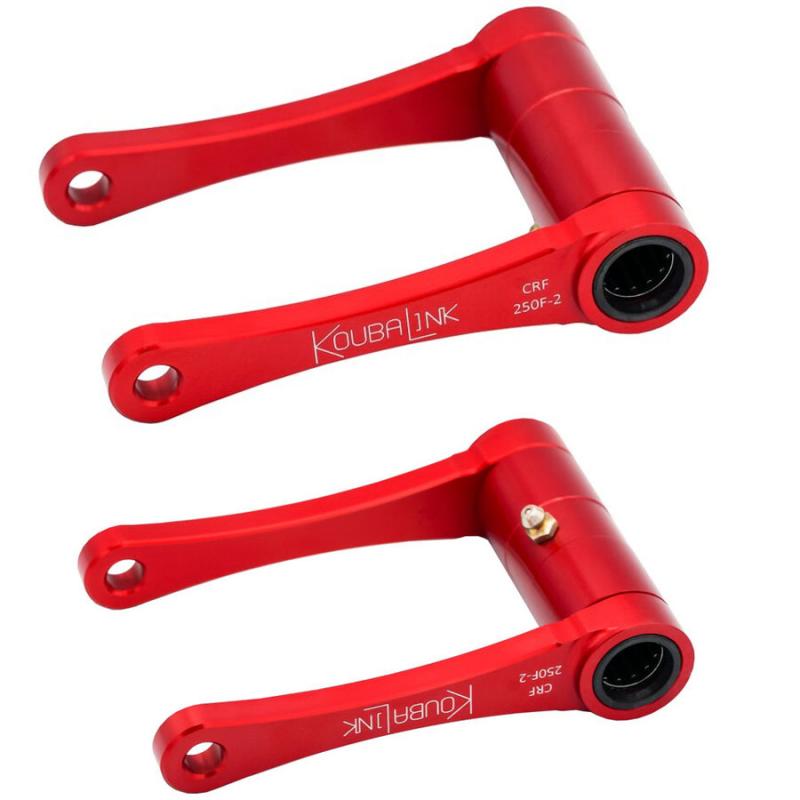- Home
- Bike Parts
- SUSPENSION
- KoubaLink Lowering Link Honda CRF 250F Air Cooled (2019-2023)
Installation Instructions (download pdf here)
1) Raise the motorcycle with a bike stand, milk crate, etc., so the rear wheel is slightly off the ground. Remove the 17 mm nuts from the two link mounting bolts and push the bolts out the right side. The swing arm may need to be raised slightly to allow the bolts to slide out freely. After removing these two bolts the link will drop out the bottom and your about ready to install the new link.
2) The new links come with the bearings and seals, so put a little grease on the two needle bearings first, and then install the "center sleeve" from your old OEM link into the KoubaLink. You are now ready to install the new link by holding it back in place with the bearing end forward and the engraving readable from the right side. After aligning the link eyes with the link mounts, push the mounting bolts back through from the right side. *You will need to raise the swing arm to get the eyes to line up.
3) After installing the KoubaLink, be sure the grease fitting is facing downward. *Left side engraving will be upside down. You may want to pump a little grease into the grease fitting now before you torque the mounting bolt nuts as sometimes after tightening the nuts the air will not escape from the bearings and is difficult to get the grease in. Install the two 17 mm nuts and torque to approx. 35 lb-ft.
4) For the 1.75" rear lowering, set the race sag (amount of vertical movement of the rear axle FROM no weight to bike weight plus rider weight) at 3.75" with rider in full riding gear, standing on the pegs. This sag adjustment can be changed by turning the two large nuts on top of the rear spring. (More preload = less sag, and less preload = more sag. Turning the spring preload nuts clockwise will increase the preload/ lessen the sag and visa versa.) The easiest way we have found to change the preload adjustment is to loosen the top jam nut, lube the threads on the shock and turn the spring and all by grasping the bottom of the spring. It will turn easier if the rear wheel is off the ground.
5) The front fork tubes can be slid up in the triple clamps until they almost touch the stock handlebars, we do not recommend going farther than the stock height handlebars allow as we are not sure exactly when the front tire would be allowed to contact the underside of the fender when fully compressed. If the front pushes or will not turn quick enough we recommend lessening the rear sag rather than sliding the fork tubes up farther.
Disclaimer: lowering the rear more than the front can change the geometry and could affect the handling, so be careful.
If you have a question, you can contact us here.

Quick Links
- Close Out Items
- Replacement Plastic
- Handguards


-
BIKE PARTS
- ALUMINUM GUARDS
- Front & Rear Disc Guards
- Radiator Frames
- Radiator Guards
- Skid Plates
- Adjustable Linkage & Link Guards
- Silencer & Pipe Guards
-

- BRAKE PADS
- BRAKE ROTORS
-

- DRIVETRAIN PARTS
- Chain Guides, Sliders & Kits
- Motorcycle Chain
-

- ELECTRICAL
- Speedometers/Tachometers
- Switches
- Stators
- Digital Radiator Fan Kits
- Horns
-
BIKE ACCESSORIES
- TIRES & WHEELS
- GEAR
- View All Categories
-
SHOP BY BRAND


 View Order / Checkout
View Order / Checkout Continue Shopping
Continue Shopping